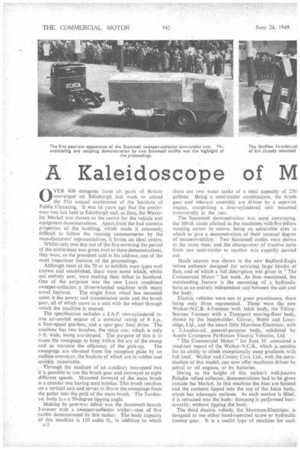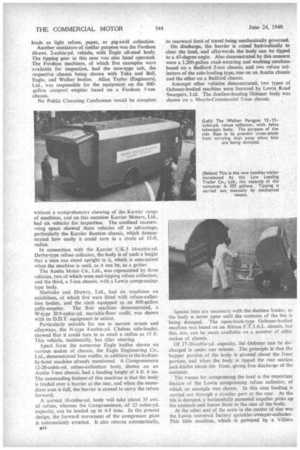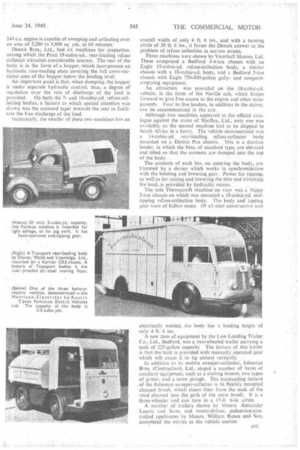A Kaleidoscope of M ipal Vehicles
Page 18

Page 19

Page 20

Page 21

If you've noticed an error in this article please click here to report it so we can fix it.
0 VER 800 delegates from all parts of Britain converged on Edinburgh last week to attend the 51st annual conference of the Institute of Public Cleansing. It was 16 years ago that the conference was last held in Edinburgh and, as then, the Waverley Market was chosen as the centre for the vehicle and equipment demonstrations, Apart from the bad acoustic properties of the building, which made it extremely. difficult to follow the running • commentaries by the manufacturers' representatives, it forms an ideal centre.
Whilst only one day out of the five covering the period of the conference was given over to these demonstrations, they were, as the president said in his address, one of the most important features of the proceedings.
Although most of the 70 or so exhibits were types well known and established, there were some which, whilst not entirely new, were making their debut in Scotland. One of the surprises was the new Lacre combined sweeper-collector, a three-wheeled machine with many • novel features. The single front wheel has mounted upon it the power and transmission units and the brush gear, all of which move as a unit with the wheel through which the machine is steered.
• The specification includes a J.A.P. two-cylindered inline air-cooled engine of a nominal rating of 8 h.p., a four-speed gearbox, and a spur-gear final drive. The machine has two brushes, the main one, which is only 3 ft. wide, being arc-shaped. The purpose of this is to cause the sweepings to keep within the arc of the sweep and so increase the efficiency of the pick-up. The sweepings are elevated from the reception plate by an endless conveyor, the buckets of which are in rubber and quickly removable.
. Through the medium of an auxiliary two-speed box it is possible to run the brush gear and conveyor at eight different speeds. Mounted forward of the main brush is a circular one having steel bristles. This brush revolves on a vertical axis and serves to throw the sweepings from the gutter into the path of the main brush. The 2-cubicyd. body hns a 50-degree tipping angle.
Making its post-war debut was the Scammell-Scarab 3-tonner with a sweeper-collector trailer—one of five outfits demonstrated by this maker. The body capacity of this machine is 110 cubic ft., in addition to which al2 there are two water tanks of a total capacity of 250 gallons. Being a semi-trailer combination, the brush gear and relevant assembly are driven by a separate engine, comprising a four-cylindered unit mounted transversely at the rear.
The Scammell demonstration was most convincing, the 100-ft. circle allotted to the machines, with five pillars running across its centre, being an admirable area in which to give a demonstration of their unusual degree of manoeuvrability. Two Scammell outfits were shown at the same time, and the change-over of tractive units from one s_emi-trailer to another was expertly carried out.
Much interest was shown in the new Bedford-Eagle refuse collector designed for servicing largeblocks of flats, and of which a full description was given in The Commercial Motor" last week. As then mentioned, the outstanding feature is the mounting of a hydraulic hoist as an entirely independent unit between the cab and the body.
Electric vehicles were not in great prominence, there being only three represented. These were the new Walker-N.C.B. 4-5-tonner with Jekta body, the TillingStevens 5-tonner with a Transport moving-floor body, shown by the bodybuilder, Glover, Webb and Liversidge, Ltd., and the smart little Morrison-Electricar, with a 2-3-cubic-yd. general-purpose body, exhibited by Austin Crompton Parkinson Electric Vehicles, Ltd.
"The Commercial Motor" for June 10 contained a road-test report of the Walker-N.C.B., which is notable for its ability to climb exceptionally steep gradients with full load. Walker and County Cars, Ltd., with the introduction of this model, can now offer machines driven by petrol or oil engines, or by batteries.
Owing to the height of this maker's . well-known Paladin refuse collector, demonstrations had to be given outside the Market. In this machine the bins are hoisted and the contents tipped into the top of the Jekta body, which has telescopic sections. As each section is filled, it is retracted into the body: dumping is performed hcirizontally, without tipping the body.
The third electric vehicle, the Morrison-Electricar, is designed to use either hand-operated screw or hydraulic tioning gear. It is a useful type of machine for such loads as light refuse, paper, or pig-swill collection.
Another miniature of similar purpose was the Fordson 10-cwt. 2-cubic-yd. vehicle, with Eagle all-steel body. The tipping gear in this case was also hand operated. The Fordson machines, of which five examples were available for inspection, had the new-type cab, the respective chassis being shown with Tuke and Bell, Eagle, and Walker bodies. Allan Taylor (Engineers), Ltd., was responsible for the equipment on the 800gallon cesspool emptier based on a Fordson 5-ton chassis.
No Public Cleansing Conference would be complete without a comprehensive showing of the Karrier range of machines, and on this occasion Karrier Motors, Ltd., had six vehicles for inspection. The confined manceuvring space showed these vehicles off to advantage, particularly the Karrier Bantam chassis, which demonstrated how easily it could turn in a circle of 15-ft. radius.
In connection with the Karrier C.K3 14-cubic-yd. Derby-type refuse collector, the body is of such a height that a man can stand upright in it, which is convenient when the machine is used, as it can be, as a gritter.
The Austin Motor Co., Ltd., was represented by three vehicles, two of which were end-tipping refuse collectors, and the third, a 5-ton chassis, with a Lewin compressingtype body.
Shelvoke and Drewry, Ltd., had six machines on exhibition, of which five were fitted with refuse-collection bodies, and the sixth equipped as an 800-gallon gully-emptier. The first machine demonstrated, a W-type 20.9-cubic-yd. movable-floor outfit, was shown with its D.D.T. equipment in action.
Particularly suitable for use in narrow streets and alleyways, the N-type 8-cubic-yd. Chelsea side-loader, showed that it could turn in as small a radius as 13 ft. This vehicle, incidentally, has tiller steering.
Apart from the numerous Eagle bodies shown on various makes of chassis, the Eagle Engineering Co., Ltd., demonstrated four outfits, in addition to the hydraulic-hoist machine already mentioned. A Compressmore 12-20-cubic-yd. refuse-collection body, shown on an Austin 5-ton chassis, had a loading height of 4 ft. 6 ins. The outstanding feature of this machine is that the body is loaded over a barrier at the rear, and when the immediate area is full, the barrier is caused to carry the refuse forward,
A normal 10-cubic-yd. body will take about 35 cwt. of refuse, whereas the Compressmore, of 12 cubic-yd. capacity, can be loaded up to 4-5 tons. In the present design, the forward movement of the compressor plate is automaticaly arrested. It also returns automatically, D14 its rearward limit of travel being mechanically governed.
On discharge, the barrier is raised hydraulically to clear the load, and afterwards the body can be tipped to a 45-degree angle. Also demonstrated by this concern were a 1,200-gallon road-watering and washing machine based on a Bedford 5-ton chassis, and two refuse collectors of the side-loading type, one on an Austin chassis and the other on a Bedford chassis.
Amongst other vehicles demonstrated, two types of Ochsner-bodied machine were featured by Lewin Road Sweepers, Ltd. The dustless-loading Ochsner body was shown on a Morris-Commercial 5-ton chassis.
Special bins are necessary with the dustless loader, as the body is never open until the contents of the bin is being dumped. The open-back-type Ochsner-bodied machine was based on an Albion F.T.3.A.L. chassis, but this, too, can be made available on a number of other makes of chassis.
Of 17-20-cubic-yd. capacity, the Wisner can be discharged in under one minute. The principle is that the hopper portion of the body is pivoted about the front portion, and when the body is tipped the rear section jack-knifes about the front, giving free discharge of the contents.
The means for compressing the load is the important feature of the Lewin compressing refuse collector, of which an example was shown. In this case loading is carried out through a circular port at the rear. As the bin is dumped, a horizontally mounted impeller picks up the contents and forces them to the rear of the body.
At the other end of the scale in the matter of size was the Lewin universal factory sprinkler-sweeper-collector. This little machine, which is powered by a Villiers
249 c.c. engine is capable of sweeping and collecting over an area of 5,280 to 8,800 sq yds. in 60 minutes: Dennis Bros., Ltd., had six machines for inspection, among which the Paxit 18-cubic-yd., rear-loading refuse collector attracted considerable interest. The rear of the body is in the form of a hopper, which incorporates an hydraulic rear-loading plate covering the full cross-sectional area of the hopper below the loading level.
An important point is that, when dumping, the hopper is under separate hydraulic control; thus, a degree of regulation over the rate of discharge of the load is
provided. On both the 7and 10-cubic-yd. refuse-collecting bodies, a feature to ,which special attention was drawn was the outward taper towards the rear to facilitate the free discharge of the load.
incidentally, the smaller of these two machines has an
overall width of only 6 ft. 6 ins., and with a turning circle of 30 ft. 6 ins., it formsthe Dennis answer to the problem of refuse collection in narrow streets.
Three machines were shown by Vauxhall Motors, Ltd. These comprised a Bedford 3-4-ton chassis with an Eagle 15-cubic-yd. refuse-collection body, a similar chassis with a 10-cubic-yd. body, and a Bedford 5-ton chassis with Eagle 750-800-gallon gullyand cesspoolemptying equipment.
An attraction was provided on the 10-cubic-yd. vehicle, in the form of the Neville cab, which hinges forward to give free access to the engine and other components. Four to five loaders, in addition to the driver, can be accommodated in the cab.
Although two machines appeared in the official catalogue against the name of Shefilex, Ltd., only one was available, as the second machine had to be shipped to South Africa in a hurry. The vehicle demonstrated was a 14-cubic-yd. rear-loading refuse-collector body mounted on a Dennis Pax chassis. This is a_ dustless loader, in which the bins, of standard type, are elevated and tilted so that the contents are dumped into the top of the body.
The contents of each bin, on entering the body, are trimmed by a device which works in synchronization with the hoisting and lowering gear. Power for tipping, as well as for raising and lowering the bins and trimming the load, is piovided by hydraulic means.
The sole Thornycroft .machine on view was a Nippy 3-ton chassis on which was mounted a lo-cubic-yd. endtipping refuse-collection body. The body and tipping gear were of Edbro make. Of all-steel construction and
electrically welded, the body has a loading height of only 4 ft. 6 ins.
A new item of equipment by the Low Loading Miler Co., Ltd., Bedford, was a two-wheeled trailer carrying a tank of 225-gallon capacity The feature of this trailer is that the tank is provided with manually operated gear which will cause it to tip almost vertically.
In addition to its mobile sweeper-collector, Johnston Bros. (Contractors), Ltd., staged a number of items of auxiliary equipment, such as a trailing broom, two types of gutter, and a snow plough. The outstanding feature of the Johnston sweeper-collector is its flexibly mounted channel brush, which clears litter from the neck of the road channel into the path of the main brush. It is a three-wheeler and can turn in a 17-ft 6-in. circle.
A number of trailers shown by Messrs. Alexander Laurie and Sons, and motor-driven, pedestrian-controlled appliances by Messrs. William Bunce and Son, completed the entries in the vehicle section.




























